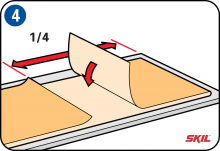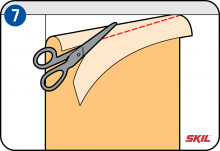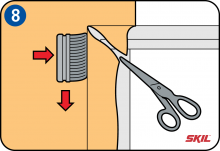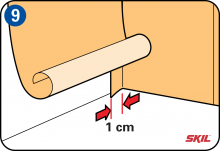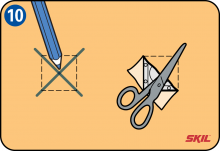-
Work out the required number of rolls
For example:
Each roll is an average of 10 meters long (1000 cm) and 53 cm wide.
If your room isn’t higher than 3 meters (300 cm), you’ll be able to apply 3 vertical runs from one roll. That may be less if the paper has a specific pattern, because this has to be matched from one run to the next. Measure the widths of all the walls and add these together. If you have high windows and doors, subtract their widths from that of the wallpaper to find the width you still need. The width of a roll is 53 cm, so divide the total width by 53 to get the required number of vertical runs.
Then divide the result by 3, because you get 3 runs out of one roll. Now you know the minimum number of rolls you need. For example, if you have a combined wall width of 4 x 600 cm or 2400 cm and a height of 265 cm, you’ll need 16 rolls (2400:53:3=15.1 or rounded-up 16 rolls). -
Step tip
Make sure all the rolls you buy have the same color code, as there can be slight color differences between rolls that appear to be the same. -
Choose the right kind of paste
Different kinds of wallpaper paste are available, depending on the thickness and material of the paper. The most commonly used kind of paste is universal, powder-based wallpaper paste. Mix and stir well to make sure the paste is smooth with no lumps. Allow to stand for 10 minutes before use. For vinyl, textile and fiberglass papers you need to use special ready mixed paste with an adhesive spreader.
-
Step tip
You can also get ready-mixed wallpaper paste. It’s even possible to get adhesive backed wallpaper, which you place in a tray of water and can then apply to the wall after a few minutes. -
Allow extra length at the top and bottom
When you’re cutting the wallpaper to length, allow a margin of 5 cm at the top and bottom. You’ll need a bigger margin if the wallpaper has a pattern that has to be matched from one run to the next. Also note if the paper has to be hung in a specific direction – you don’t want flowers that are facing downwards!
-
Applying the paste
Place the run of wallpaper on a clean pasting table with the printed side facing downwards. Apply the paste with the paste brush, fold half of the pasted part over towards the center and lay the paper on the floor. Leave the paste to bond with the paper, and while you’re waiting you can place the next run of wallpaper on the table.
-
Step tip
Keep the time you take to apply the paste as far as possible the same to allow for stretching of the paper -
Hanging the first run
Walls and window frames aren’t always exactly vertical. Use a plumbline (a weight hanging from a length of string) to check if that’s the case. The best way to start hanging wallpaper is at a door or window frame with an overlap of 3 cm over the frame.
-
Hanging the wallpaper
Fold the top part of the run of pasted wallpaper open and hang it with an overlap of 5 cm at the ceiling. Smooth the wallpaper out carefully against the wall with a clean wallpaper brush. Press the wallpaper into place, working outwards from the center to the edges. Use the back edge of the blade of a pair of scissors to press the paper into the line between wall and ceiling, creating a fold in the paper.
-
Trim off the excess wallpaper
Carefully pull the top part of the wallpaper away from the wall and trim off the excess along the fold line with the scissors. Or you can place a strip of wood in the corner and cut the wallpaper off along it with a hobby knife. It’s easier to do this if you let the paste dry for a while.
-
Finishing at door and window frames
Cut into the excess wallpaper at the door and window frames at an angle of 45°. Use the back edge of the blade of the scissors again to press the paper against the edge of the door or window frame, creating a fold in the paper. Then you can trim the wallpaper along this line.
-
Hanging the following runs
It’s best to hang the runs of wallpaper edge-to-edge without overlap. Then press the joins into place with a clean cloth or a wallpaper roller. Remove paste residues carefully with a damp sponge.
Hanging in the corner
In a corner of the room it’s easier to hang the wallpaper if it just reaches 1 cm around the corner. Cut the wallpaper lengthways and press it firmly into the corner. Then hang the other half of the run of wallpaper, or a new run, directly over the 1 cm overlap in the corner. -
Hanging around wall outlets and switches
First switch off the electricity at the mains and then remove the cover plate of the outlet or switch. You can then hang the wallpaper straight over the top of the outlet or switch. Then use the scissors to cut out the required opening, working from the center to the corners. Cut the resulting flap off in a straight line to uncover the outlet or switch. Then fit the cover plate back in place.
-
Hanging around radiators
It’s always difficult to hang wallpaper behind radiators. It’s best to cut lengthways into the paper to the place where the water pipes come out of the wall. Then cut off the run of wallpaper over the total height of the radiator. Then you can press the rest of the wallpaper run against the wall with a broom handle around which you’ve wrapped a piece of cloth, or with a clean paint roller. Alternatively you can unfasten the radiator from the wall and support it with a block of wood or a few books. Take care that you don’t twist the pipes and joints too much so that they start to leak.




